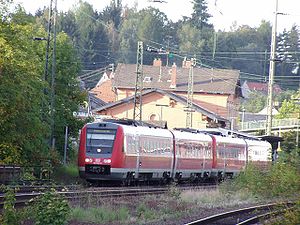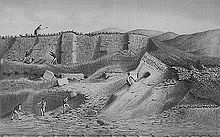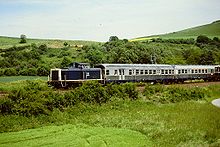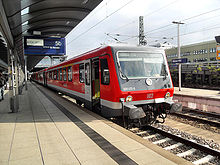- Nahe Valley Railway
-
Nahe Valley Railway Route number: 672 (Bingen–Bad Kreuznach)
680 (Bad-Kreuznach–Saarbrücken)Line length: 141.8 Gauge: 1435 Voltage: Türkismühle–Saarbrücken:
15 kV 16.7 Hz ACMaximum speed: 160 State: Rhineland-Palatinate, Saarland Legend
Left Rhine Railway from Koblenz 
0.0 Bingen (Rhein) Hbf (wedge station) 
Left Rhine Railway to Gau Algesheim 
2.7 Münster-Sarmsheim 
former line from Hindenburg Bridge 
B 9 
A 61 
5.9 Laubenheim (Nahe) 
8.0 Langenlonsheim 
Hunsrückquer Railway to Simmern 
11.5 Bretzenheim (Nahe) 
B 41 
14.6 Bad Kreuznach Gbf 
Nahe (first of 13 crossings on the line) 
Strategic railway from Gau Algesheim 
16.2 Bad Kreuznach (wedge station) 
(line to Bad Münster formerly had 4 tracks) 
Nahe 
20.1 Bad Münster am Stein 
20.4 Alsenz Valley Railway to Hochspeyer 
20.5 B 48 
20.7 former Glan Valley Railway to Homburg 
22.2 Great Norheim Tunnel (235 m) 
22.5 Little Norheim Tunnel (76 m) 
23.3 Norheim 
25.9 Niederhausen (Nahe) 
31.2 Waldböckelheim 
33.5 Boos Tunnel (424 m) 
former Glan Valley Railway (Draisine operations) 
35.3 Staudernheim 
38.4 Bad Sobernheim 
42.7 Monzingen 
47.0 Martinstein 
49.2 Hochstetten (Nahe) 
B 41 
53.0 Kirn 189 m 
56.5 Kirn-Sulzbach (previously Kirnsulzbach) 
60.5 Fischbach-Weierbach 
63.8 Nahbollenbach 
65.6 Gefallener-Fels Tunnel (201 m) 
67.9 Idar-Oberstein 264 m 
68.5 Homerich Tunnel (388 m) 
69.2 Enzweil Tunnel (466 m) 
70.2 Enzweiler 
73.5 Sonnenberg (Nahe) (closed 1963) 
73.6 Frauenberg Tunnel (407 m) 
75.3 Kronweiler 
75.5 Kupferheck Tunnel (211 m) 
77.3 Bockspiel Tunnel (120 m) 
77.7 Nohen 
79.2 Brämericher Tunnel (209 m) 
80.7 Heimbach (Nahe) 
line to Baumholder 
81.3 Jährodt Tunnel (125 m) 
82.1 Mausemühle Tunnel (145 m) 
83.7 Hoppstädten (Nahe) 
former line from Birkenfeld 
85.7 Neubrücke (Nahe) 
A 62 
Nahe (last of 13 crossings on the line) 
Rhineland-Palatinate/Saarland border 
B 41 
89.6 Nohfelden 
former Westrich Railway from Schwarzerden 
91.8 Türkismühle 364 m 
Hochwald Railway to Hermeskeil 
Walhausen (Saar) / Brunnenstraße 
94.6 Walhausen (Saar) 
96.0 high point 384.4 m 
98.6 Namborn 
B 41 
100.9 Hofeld 
103.0 Baltersweiler 
St. Wendel / Kelsweilerstraße 
former line from Tholey 
Blies 
106.3 St. Wendel 
Blies 
108.1 Oberlinxweiler 
Blies (2x) 
111.2 Niederlinxweiler 
Blies (2x) 
Oster Valley Railway from Schwarzerden 
114.8 Ottweiler (Saar) 
117.9 Wiebelskircher Tunnel (313 m) 
118.5 Wiebelskirchen 


line from Homburg 


120.6 Neunkirchen (Saar) Hbf (wedge station) 


Fischbach Valley Railway to Schiffweiler 


123.1 Neunkirchen Hbf junction 


former line to Neunkirchen-Heinitz 


Königsgrube (mine) 


former connection to Schiffweiler 


B 41 


124.9 0.0 Landsweiler-Reden 


Reden Grube (mine) 


1.9 Itzenplitz Grube (1860-1958) 
127.5 Bildstock 

(former route until 1955) 

127.7 Bildstock Tunnel (old, 481 m) 

127.9 Bildstock Tunnel (new, 341 m) 

(former route until 1955) 
Friedrichsthal (Saar)-Mitte 
129.6 Friedrichsthal (Saar) 
Sulzbach viaduct, A 8 
131,8 Sulzbach (Saar)-Altenwald 
133.1 Sulzbach (Saar) 
136.4 Dudweiler 


Beginning of freight railway (GUB) 


138.5 Jägersfreude 


A 623 


139.0 Saarbrücken marshalling yard N (junction) 


Saarbrücken marsh. yard / freight yard 


140.9 Saarbrücken Hbf Srg 


Saarbrücken marsh. yard W (junction) (GUB) 


Palatine Ludwig Railway from Homburg
and line from Sarreguemines
141.9 Saarbrücken Hbf 
Fischbach Valley Railway to Wemmetsweiler 
Forbach Railway to Metz 
Saar line to Trier The Nahe Valley Railway is a two-track, partially electrified main line railway in the German states of Rhineland-Palatinate and Saarland. It was built by the Rhine-Nahe Railway Company and connects Bingen am Rhein on the Left Rhine line with Saarbrücken. It was opened between 1858 and 1860 and is one of the oldest railways in Germany. The section south of Bad Kreuznach is part of the regionally important transport corridor between the two major cities of Mainz and Saarbrücken.
Contents
History
In 1839 there were plans to build a rail link between the Saar and the Rhine river, which could not be realised because of its high construction costs. In 1856 construction of the line was undertaken by the private Rhine-Nahe Railway Company (German: Rhein-Nahe Eisenbahn-Gesellschaft, RNE) set up for this purpose. It would connect the Nahe Valley and the surrounding area with the Left Rhine line of the Rhenish Railway Company (Rheinischen Eisenbahn-Gesellschaft, RHE) and the Hessian Ludwig Railway (Hessische Ludwigsbahn) in Bingerbrück and would stimulate economic development and open up the market for Saar coal by connecting the Saarland railways with the Middle Rhine Valley. It was proposed that the line be privately financed with a government guarantee of a return of four percent. The Prussian government took control of the project on 18 June 1856 and issued the concession for the railway’s construction and operation to the company on 4 September 1856. Contracts were signed to allow the line to run through Meisenheim, part of Landgrave of Hesse-Homburg, and the Principality of Birkenfeld, part of the Grand Duchy of Oldenburg, allowing construction of the 120 km long line to begin in 1857.
Construction of the line
The first 16 km section from Bingerbrück (now Bingen Hauptbahnhof) to Bad Kreuznach went into operation on 15 July 1858. This was followed by the sections to Oberstein on 15 December 1859 and to Neunkirchen (Saar) via Birkenfeld (now Neubrücke) and St. Wendel on 26 May 1860, with a total length of 52 or 53 km. Even before the construction the line was finished, the Royal Railway Administration at Saarbrücken (Königliche Eisenbahn-Direction zu Saarbrücken) took over its management and operation. The railway was considered a regional lifeline that would promote industrialisation in this agricultural area of the upper Blies Valley and the Nahe Valley, which was affected by high unemployment, rural exodus and emigration.
In Neunkirchen there was a connection with the Royal Saarbrücken Railway. The line connected on the Rhine in Bingerbrück with the Left Rhine line opened by the Rhenish Railway Company on 17 October 1859. This was followed by a connection with the Hessian Ludwig Railway to Mainz on 15 December 1859. At the beginning of November 1861 this was followed by the opening of the Bingerbrück–Rüdesheim train ferry, connecting to the Nassau Rhine Railway, opened in 1856 by the Wiesbaden Railway Company (Wiesbadener Eisenbahngesellschaft), which was nationalised in 1861 as the Nassau State Railway (Nassauische Staatsbahn).
The 121 km long line of the Rhine-Nahe Railway Company was called by Arthur von Mayer the most expensive line in Germany; this was the result of its very difficult construction, which included a large number of tunnels, bridges, embankments and cuttings. The construction cost more than one million thalers per Prussian mile (7,532.5 metres), then a record sum.
The revenue of the company after the start of operations was well short of expectations. Since the passenger traffic met the expectations of the builders only to the spas of Kreuznach and Münster, neither dividends nor interest on debt could be paid. As a result, the Prussian government was obliged to step in to meet its annual interest rate guarantee. This also meant that the government was unable to sell the line to the Rhenish Railway after the War of 1866.
The Birkenfeld station was five kilometres from the capital of the Principality of Birkenfeld. Therefore, the town and Degussa GmbH funded the construction of a railway from the town of Birkenfeld to Neubrücke. The original Birkenfeld was renamed Neubrücke station. RNE took over the management of the Birkenfeld Railway and opened it on 5 October 1880.
As the line formed part of a route to the French border, it was soon duplicated. The line was connected to the Hindenburg Bridge, which was built between Rüdesheim am Rhein and Bingen-Kempten for strategic reasons. The bridge was built between 1913 and 1915 and destroyed in 1945. It connected a junction in Münster-Sarmsheim on the Nahe Valley Railway with the Right Rhine line. Because of the great military importance of the line, the RNE was acquired by the Prussian government with effect of 1 April 1881 and the company was dissolved. From 1 July 1883 it was part of the Royal Railway Administration at Cologne, left Rhine (Königlichen Eisenbahndirektion Köln, linksrheinisch) of the Prussian state railways.
New tunnel Construction
Coal was mined near the original Bildstock Tunnel (481 m) and a pillar of coal had to be left in place to support the foundations of the tunnel. The former Saargruben (later Saarbergwerke AG; today: DSK) mining company wanted to remove this to extend its mine. In 1955, therefore, the new Bildstock Tunnel (341 m) was built with an improved 600 m radius, bypassing the former tunnel.
Accidents
On 16 January 1918, the embankment between Kern and Hochstetten (Nahe) was washed away during a storm by the Nahe and subsided. This caused the derailment of leave train 243, causing the locomotive, van and three passenger carriages to plunge into the river. 38 people were killed and 25 wounded.
Route
Between Bad Kreuznach and Türkismühle the route runs primarily on the north side of the Nahe. The line crosses the Nahe twice in the four km section between Bad Kreuznach and Bad Münster and eleven times between Bad Münster and Idar-Oberstein. The line runs along the Blies between St. Wendel and Neunkirchen (Saar) Hbf.
The Nahe Valley Railway runs largely parallel to federal highway 41 and their paths cross several times. The first crossing takes place north of Bad Kreuznach. The railway and highway run parallel from Bad Sobernheim through the Nahe valley, until the road leaves the valley in the Idar-Oberstein district of Enzweiler. The railway and road also run parallel on a second, much shorter section between Neubrücke (Nahe) and Nohfelden.
South of Namborn the railway line crosses the road again and the two run parallel with the course of the Blies between St. Wendel and Ottweiler. West of Neunkirchen, highway 41 crosses the line one last time. The line crosses the A 8 and A 623 autobahns on its way to Saarbrücken Hauptbahnhof.
Track upgrading
The Türkismühle–Saarbrücken Hauptbahnhof section has been electrified since 1969. The Saarbrücken–St. Wendel section was already electrically in 1968.
The Neubrücke–Heimbach section was operated on a single track for several months in 2007 to allow tunnel refurbishment works and to enlarge of the inner radius of the tunnel from four to five metres. Further work is being carried out on the line to allow it to be electrified.
Operations
The Saarbrücken–Türkismühle section has long had a dense service. After the line was electrified, services were mainly operated with Silberling carriages hauled by class 140 and 141 electric locomotives. North of Türkismühle class VT 95 (795) and VT 98 (798) railbuses were often used.
Express trains running between Saarbrücken, Idar-Oberstein, Bad Kreuznach, Bingen, Mainz and Frankfurt am Main were also mostly formed of Silberling carriages hauled by class 01 steam locomotives and later by class V200 and 218 diesel locomotives.
Already in 1960 there were long-distance trains between Paris Gare de l'Est and Frankfurt, which stopped only at Saarbrücken, Neunkirchen, St Wendel, Neubrücke, Heimbach, Idar-Oberstein, Kirn, Bad Sobernheim, Bad Münster, Bad Kreuznach, Bingerbrück and Mainz.
In 1985 the line was upgraded. The D 258/59 express from Paris Est to Frankfurt operated over the Alsenz Valley Railway between Kaiserslautern and Bad Kreuznach, using French carriages and was hauled from Saarbrücken to Frankfurt by class 218 diesel locomotives. This was followed in 1988 by a pair of D-trains (expresses) on the Saarbrücken–Frankfurt–Kassel–Göttingen route, which also ran over the Nahe Valley Railway. In 1990 these long distance services were discontinued.
Today, there is continuous service of class 612 tilting trains on the Frankfurt–Saarbrücken route, run as the Rhine-Nahe-Express (RE3) Regional-Express service. Every second train runs to and from Frankfurt stops at the Frankfurt Airport Regional station.
Regionalbahn line RB 73 services operate on the Türkismühle–Saarbrücken section with class 425 and 426 electric multiple units. RB 33 services operate on the Türkismühle-Mainz section line with class 628 and 643 diesel multiple units.
References
- Brumm, R. (1986/87) (in German). Die Rhein-Nahe-Bahn. Bingerbrück bis Neunkirchen. Edition Nahetal.
- Eisenbahnatlas Deutschland (German railway atlas) 2007/2008 edition. Schweers + Wall. 2007. ISBN 978-3-89494-136-9.
Weblinks
- "Photographs of tunnel portals, including a section on tunnel enlargment" (in German). Tunnelportale. http://www.eisenbahntunnel-portal.de/lb/inhalt/tunnelportale/3511.html. Retrieved 28 December 2010.
- "Old and new Bildstock Tunnels" (in German). Tunnelportale. http://www.eisenbahntunnel-portal.de/lb/inhalt/tunnelportale/3511-bildstock-lage.html. Retrieved 28 December 2010.
Categories:- Railway lines in Rhineland-Palatinate
- Railway lines in the Saarland
Wikimedia Foundation. 2010.




